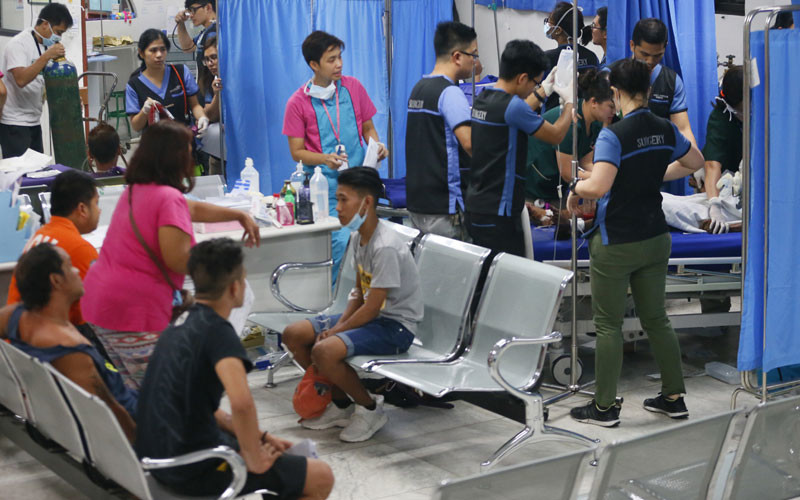
Doctors treat victims for mostly firecracker-related injuries, during a raucous celebration of New Year Sunday, Jan. 1, 2017 in Manila, Philippines. The country’s notorious tradition of dangerous New Year’s Eve celebrations persisted after President Rodrigo Duterte delayed to next year his ban on the use of powerful firecrackers, often worsened by celebratory gunfire.(AP Photo/Bullit Marquez)
For many years, the Inquirer has joined its voice to the chorus of criticism against the dangerous and sometimes even deadly Dec. 31 tradition: igniting firecrackers to herald the New Year. Any decrease in the number of cracker-related injuries is and should always be welcome. The way the Department of Health handled this year’s good news, however, left an acrid taste—almost like that of gunpowder—in the mouth.
On Sunday, Health Secretary Paulyn Jean Ubial announced that the total number of firecracker injuries recorded was only 350, and welcomed what she called a “remarkable” decline in the statistics. It was the lowest in a decade, she said, and singled out one cause: fear of President Duterte.
On Monday, DOH spokesperson Dr. Eric Tayag noted that the total had in fact risen to 524. On Twitter, he said this was still 40-percent lower than the five-year average from 2011 to 2015.
On Tuesday, Tayag reported that the new total was now 581, still about a third lower than the same five-year average. He attributed the additions to three factors: delayed reports, delayed consultations, or outright new cases.
This is still progress, but unfortunately, the department’s handling of the matter, or specifically Ubial’s, provoked controversy instead of celebration.
As the daily statistics updates showed, she had jumped to a highly premature conclusion. Did anyone on her staff advise her that the old problems of delayed reports and delayed consultations needed to be taken account of, before announcing a grand decline? Did she herself understand that new cases can still be reported, in the usual monitoring period the department itself has set? (This year, the reporting period is from Dec. 21, 2016 to tomorrow, Jan. 5—which means the number of cases might still go up.)
But it wasn’t only the statistics Ubial fumbled; the government’s foremost health professional also politicized the interpretation of those same statistics. She said on Sunday: “People are now afraid to light firecrackers because of the President. They have this impression that somehow they will get caught or they will be punished.” She wasn’t finished. This year’s total (as of Sunday), she said, “is the lowest ever. We can’t say it’s just a coincidence. This is remarkable and very significant.”
It is possible, of course, that fear of Mr. Duterte was a factor, although we would be interested to know the reasoning that went into Ubial’s judgment that the decline couldn’t have been a coincidence. The wave of extrajudicial killings could also have dampened the spirit of revelry. After all, even though a majority of Filipinos say they support the war on drugs, a majority also say that suspects should not be killed and that Filipinos fear being caught in the war.
Secretary Ubial’s instant analysis of the still-incomplete numbers, then, came across as prefabricated—to borrow both word and concept from George Orwell’s “Politics and the English Language.” She had an existing narrative in mind, and thought or assumed that the statistics were “remarkable and very significant.” It is now clear that she was predisposed to see the significance, regardless of the statistics.
This is unfortunate. The health department is one of the few government agencies where the latest in science can be made both available and understandable to the ordinary citizen. Indeed, Ubial demonstrated this fact herself, when she publicly took issue with the police version of the incident involving the teenager Emilyn Villanueva, who was hit by a bullet. “If it’s a shooting incident, the trajectory of the bullet that hit the victim would not be like that. We still categorize it as [a] stray bullet from indiscriminate firing because the bullet hit the child on the head at the trajectory of a stray bullet: vertical.”
Clear and straight, and most helpful. This is the standard we should expect from the DOH; we should have more science, less politics.

